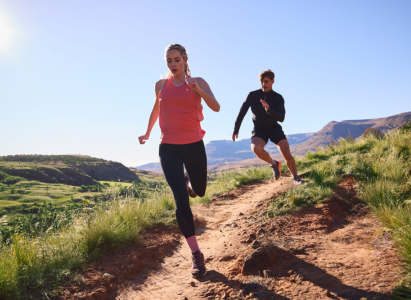
You enjoy running, you've ran a few races and you've done a few park runs and you want to know what's next? If you're finding yourself getting a little bit bored of clocking in the miles on pavement then why not look into trail running?
The most simple definition of trail running is running in nature. Doesn't need to be on a specific trail or location, just outdoors and not in a built up area. You can find out more about what trail running exactly is, in our What is Trail Running? blog.
This guide is going to focus more on how you can get started trail running. That includes staying safe, fueling yourself correctly and finding different trails.
How to Start Trail Running
The first thing you need to do once you've decided to start trail running is to find a trail. As a beginner, you'd be better suited to find somewhere that is sign posted, close to home and doesn't have too much of a difficult terrain. Think about country parks, nature reserves or woodland paths. Ideally somewhere you could get too easily and isn't too big. You don't need to be doing a 10K, just 2/3 miles is perfect for you to get a feel for the route.
Some good tools to use to find different routes are tracking apps like AllTrails, Komoot or even Strava. People can map out previous runs that they have done and you can follow these maps.
When you go trail running, you will need to change your running technique as there are more things to consider.When running, make sure you're more aware of your surroundings. Keep your gaze ahead and scan for any hazards that may be around. Be more conscious with your foot placement and avoid hunching over and having stiff shoulders. Keeping a straight back and soft limbs will help you feel more comfortable and make it easier to engage your core.
Another easy way to start your trail running journey is by joining a trail running group. This is the perfect way to really get engrained and learn from others. It also means you don't need to add any forethought into the trail, you can follow the group. Many of them will be beginner friendly, but it is always worth double checking with the organisers.
Trail running isn't about getting record times, or smashing PBs - it's more about exploring and spending more time in nature.
Staying Safe on The Trails
There are more hazards that you need to be aware of when you're trail running. So it's important that you're prepared, more than you would be on a road run.
Whenever you're out on a trail, make sure you inform friends or family where you're going, how long you expect to be on the run for and if possible share your location. Or even better, why not try and take a running buddy with you?
Gear wise, a running vest or backpack will make your life easier and allow you to carry more. You should include a fully charged phone, a lightweight waterproof jacket (weather depending), a headlight (if you know you are out later in the day and it may have the possibility of getting dark before you finish your run) and a mini first aid kit. Other essentials include a whistle that can help attract noise and attention in an emergency and a safety blanket.
When it comes to your trail running clothing, look for items that have reflective sections and panelling so that you are visible in low lighting.
Don't forget to stay hydrated and bring some high energy snacks along with you incase you need that boost mid run.
Fueling Your Trail Run
There are three different stages you need to be thinking about when looking at fueling your run: pre run, mid run and post run.
Pre run: Eat your meal around 2/3 hours before. Look at easily digestible carbs and some protein for satiety. Avoid high fibre, heavy and fatty foods as that can cause stomach upset. Make sure you're staying hydrated but don't over drink as that can also cause some discomfort.
Having food mid run can depend on a few different things. If you're running for an hour or under, you might likely won't need to eat anything to fuel up during the run. For longer runs, look at refueling with easy to carry snacks like bananas, energy bars or gels. If you're going to be heavily sweating then look at adding some electrolytes into your water.
Post run: After the run, you're aiming to rehydrate, replenish your energy stores and repair muscle. You don't want to eat too soon after your run, wait around 30/60 minutes then eat. Think about a balanced meal so something that has a good mix of carbs, protein and healthy fats. And don't forget to keep hydrating.
Getting into trail running means that opening up the amount of adventures and exploring you can have. You're not restricted to pavements any more and you can really get back to nature. If you're someone who has never gotten along with the idea of constantly having to beat your own personal bests and run faster and faster, you just want to be out and enjoying yourself then get on your trail running trainers and get out there.
